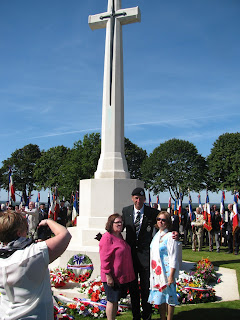Where: Vimy Ridge Memorial (Arras), tunnels at Wellington Quarry, Cabaret Rouge Canadian Cemetery, German cemetery at Neuville St. Vaast.
Theme: The Notion of Missing During the First Woorld War
Questions:
Why did so many go missing in 1916? How did the war change in 1917?
How Canadian was the Canadian Corps?
How significant was the Vimy Ridge victory and the Canadian contribution?
and Has large-scale memorialization of war sacrifice lost its relevance?
Me in the trenches at Vimy Ridge
Reflections:
If, as someone today said, "World War I change[d] the narrative of war" I think it was the time between the Somme and Vimy Ridge that had the most change.
In answer to the first question (part b), the war changed to better address the realities of the new technology. In 1916, officers held on to old ideas of how to fight a war that were out of date with the reality of trench warfare and machine guns - calvary going in after infantry broke the line no longer a real option. Chris Evans (our historian on tour) spoke about how scientific fighting became in response to the technology. There was a science to fighting heavy artillery that was so detailed they were concerned with the rotation of the earth in determining precisely where a shot would land. And how much each subsequent shot would change due to the change in friction between the shell and the barrel of the gun after each shot. In terms of teaching this in class - there is potential for some cross-curricular connections, or for independent student research depending on student's interest in science. (Good ideas as I continue to think about instituting a 20% time project in grade 10 Canadian history.) I need to look up AGL MacNaughton (spelling?) as the person in charge of finding German artillery using science so the Allies could take it out. What a novel idea - take out the enemies weapons so they can't use them against you! He apparently becomes a bigger player in World War II.
One interesting detail I learned about the fighing (and scientific approach) at Vimy Ridge was about the rolling barrage. I understood the basics, but didn't know the particulars. Did you know the soldiers had to cover 100 yards in 3 minutes because it was after 3 minutes that the barrage would recalculate to hit slightly further? Would I take my students out to the football field and have them walk it in 3 minutes? Talk about the importance of the timing? Too soon and you walk into your own artillery range, too slow and the Germans have a chance to move out of hiding before you get there? This is often the type of thing I dismiss as a waste of time, but maybe ...?
Something else that was new to me was that Vimy Ridge was actually a small part of a much bigger offensive in this part of the Western Front. It was actually a distraction to bring Germans away from the bigger attack planned one week later slightly further south on the line.
I sometimes debate with a friend how important (or not) Vimy Ridge is. I like it because of the sense of birth of a nation. He thinks the 'birth of a nation' idea came after the monument and the monument was uncalled for. Marie-Eve (JBC's History Department Manager) made the point at supper that Vimy Ridge was chosen for a Canadian monument because the location was prosperous (mining resources) and they thought that would encourage people to visit. Based only on success and significance of a battle, somewhere from the 100 Days would have made more sense (maybe you win Jamie). Unfortunately the mining economy in the Artois region went bust after the war and it is no longer a wealthy area.
Other Reflections:
The difference between the Allied and German cemeteries was striking. The grave markers and the upkeep of the grounds.
Cabaret Rouge Commonwealth Cemetery
Neuville-St Vaast German war cemetery
In a sea of fairly plain crosses for the German cemeteries, there were a few tombstones for Jewish soldiers. Never thought about Jews fighting for Germany in World War I.
The sheer number of unnamed graves was staggering. It was interesting to see that they gave as much information as they could about a falled soldier. Some men had just nationality and death date, some had divisions and ranks without names. Isn't that the point of dog tags?
One last learning from today: In World War One (and prior) many countries recruited regionally with brothers, friends, neighbours fighting in the same regiment. Because of devestating losses in WWI (ie: Beaumont-Hamel) towns lost their whole young male population. Recruitment policies changed to not have people fight with others from the same area.
Sneak peak for tomorrow - my feet in the water at Dieppe





































